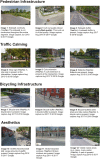Assessing the micro-scale environment using Google Street View: the Virtual Systematic Tool for Evaluating Pedestrian Streetscapes (Virtual-STEPS)
- PMID: 31500596
- PMCID: PMC6734502
- DOI: 10.1186/s12889-019-7460-3
Assessing the micro-scale environment using Google Street View: the Virtual Systematic Tool for Evaluating Pedestrian Streetscapes (Virtual-STEPS)
Abstract
Background: Altering micro-scale features of neighborhood walkability (e.g., benches, sidewalks, and cues of social disorganization or crime) could be a relatively cost-effective method of creating environments that are conducive to active living. Traditionally, measuring the micro-scale environment has required researchers to perform observational audits. Technological advances have led to the development of virtual audits as alternatives to observational field audits with the enviable properties of cost-efficiency from elimination of travel time and increased safety for auditors. This study examined the reliability of the Virtual Systematic Tool for Evaluating Pedestrian Streetscapes (Virtual-STEPS), a Google Street View-based auditing tool specifically designed to remotely assess micro-scale characteristics of the built environment.
Methods: We created Virtual-STEPS, a tool with 40 items categorized into 6 domains (pedestrian infrastructure, traffic calming and streets, building characteristics, bicycling infrastructure, transit, and aesthetics). Items were selected based on their past abilities to predict active living and on their feasibility for a virtual auditing tool. Two raters performed virtual and field audits of street segments in Montreal neighborhoods stratified by the Walkscore that was used to determine the 'walking-friendliness' of a neighborhood. The reliability between virtual and field audits (n = 40), as well as inter-rater reliability (n = 60) were assessed using percent agreement, Cohen's Kappa statistic, and the Intra-class Correlation Coefficient.
Results: Virtual audits and field audits (excluding travel time) took similar amounts of time to perform (9.8 versus 8.2 min). Percentage agreement between virtual and field audits, and for inter-rater agreement was 80% or more for the majority of items included in the Virtual-STEPS tool. There was high reliability between virtual and field audits with Kappa and ICC statistics indicating that 20 out of 40 (50.0%) items had almost perfect agreement and 13 (32.5%) items had substantial agreement. Inter-rater reliability was also high with 17 items (42.5%) with almost perfect agreement and 11 (27.5%) items with substantial agreement.
Conclusions: Virtual-STEPS is a reliable tool. Tools that measure the micro-scale environment are important because changing this environment could be a relatively cost-effective method of creating environments that are conducive to active living.
Keywords: Active living; Audit; Built environment; Google Street View; Micro-scale; Pedestrian; Physical activity; Virtual; Walkability.
Conflict of interest statement
The authors declare that they have no competing interests.
Figures
Similar articles
-
Virtual audits of streetscapes by crowdworkers.Health Place. 2019 Sep;59:102203. doi: 10.1016/j.healthplace.2019.102203. Epub 2019 Sep 11. Health Place. 2019. PMID: 31521005
-
Moving to policy-amenable options for built environment research: The role of micro-scale neighborhood environment in promoting walking.Health Place. 2020 Nov;66:102462. doi: 10.1016/j.healthplace.2020.102462. Epub 2020 Oct 26. Health Place. 2020. PMID: 33120068
-
Virtual audits of the urban streetscape: comparing the inter-rater reliability of GigaPan® to Google Street View.Int J Health Geogr. 2020 Aug 12;19(1):31. doi: 10.1186/s12942-020-00226-0. Int J Health Geogr. 2020. PMID: 32787861 Free PMC article.
-
Meteorological gaps in audits of pedestrian environments: a scoping review.BMC Public Health. 2024 Jul 27;24(1):2010. doi: 10.1186/s12889-024-19441-6. BMC Public Health. 2024. PMID: 39068394 Free PMC article.
-
Promoting activity participation and well-being among children and adolescents: a systematic review of neighborhood built-environment determinants.JBI Evid Synth. 2020 Mar;18(3):370-458. doi: 10.11124/JBISRIR-D-19-00051. JBI Evid Synth. 2020. PMID: 32197008
Cited by
-
Effect of the Street Environment on Walking Behavior: A Case Study Using the Route Choice Model in the Chunliu Community of Dalian.Front Public Health. 2022 May 10;10:874788. doi: 10.3389/fpubh.2022.874788. eCollection 2022. Front Public Health. 2022. PMID: 35619822 Free PMC article.
-
Validation of desk-based audits using Google Street View® to monitor the obesogenic potential of neighbourhoods in a pediatric sample: a pilot study in the QUALITY cohort.Int J Health Geogr. 2022 Mar 26;21(1):2. doi: 10.1186/s12942-022-00301-8. Int J Health Geogr. 2022. PMID: 35346220 Free PMC article.
-
Preference for Street Environment Based on Route Choice Behavior While Walking.Front Public Health. 2022 Aug 5;10:880251. doi: 10.3389/fpubh.2022.880251. eCollection 2022. Front Public Health. 2022. PMID: 35991076 Free PMC article.
-
Associations between body mass index, physical activity and the built environment in disadvantaged, minority neighborhoods: Predictive validity of GigaPan® imagery.J Transp Health. 2020 Jun;17:100867. doi: 10.1016/j.jth.2020.100867. Epub 2020 May 3. J Transp Health. 2020. PMID: 32368490 Free PMC article.
-
Adapting the SPOTLIGHT Virtual Audit Tool to assess food and activity environments relevant for adolescents: a validity and reliability study.Int J Health Geogr. 2021 Jan 18;20(1):4. doi: 10.1186/s12942-021-00258-0. Int J Health Geogr. 2021. PMID: 33461559 Free PMC article.
References
-
- Cain KL, Millstein RA, Sallis JF, Conway TL, Gavand KA, Frank LD, et al. Contribution of streetscape audits to explanation of physical activity in four age groups based on the microscale audit of pedestrian streetscapes (MAPS) Soc Sci Med. 2014;116:82–92. doi: 10.1016/j.socscimed.2014.06.042. - DOI - PMC - PubMed
MeSH terms
LinkOut - more resources
Full Text Sources
Miscellaneous



